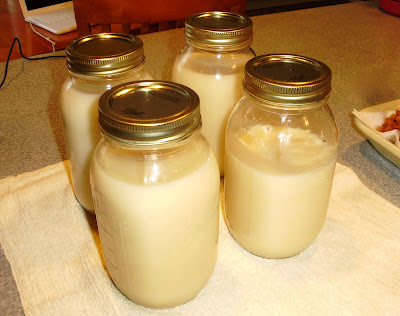We received our pastured pig last week. I was so pleased that I was able to tell the processing plant exactly which cuts we wanted and that it was processed naturally without nitrites or nitrates. I was even able to get the fat from our pig. After doing a lot of reading and research, I realized that lard is not the villain it has been made out to be in recent times. So, I set out to render our pig fat into lard for cooking and teach you as I learned as well. You're welcome. :0)
First of all, I was surprised that this was all the fat that came off of a 265 pound porker.
After opening the vacuum sealed bag of pork fat, I started slicing it. Kind of reminds you of a fish filet, no?
Cut the fat into small squares, about half and inch or so, and put it in a stock pot on med low heat.
Actually, this is where it gets very flexible. You can do this in a stock pot, a crock pot on low, or in the oven at about 325 degrees. They all work. It just really depends on what you're most comfortable with. Any way you go about it, the fat will start to turn colors as it begins to heat up and melt.
This needs to be stirred periodically to keep it from burning. It will get very hot and bubbly as the fat melts down, even on low heat. This takes a really long time. I put mine in the stock pot about 2 or 3 in the afternoon, which was too late. So, before bed I switched to the crock pot method. It was done about 2 in the morning. Granted, I had an awful lot of lard to render. It probably wouldn't take 12 hours if you weren't doing the fat from an entire pig.
I knew it was done when the bits of fat and meat were golden brown and sitting on the bottom of the pot. Those little golden bits that are left are called cracklins. And, boy are they yummy! They can be eaten as a snack or used on salad. Anyway, I lined a platter with paper towels, pulled out the cracklins with a slotted spoon and laid them on the platter to soak up any excess oil.
The next step was to line a funnel with cheese cloth (or paper towels or coffee filters) and begin ladling the hot lard into mason jars.
Doing this filter system catches more bits-n-pieces.
The resulting liquid is a beautiful golden color...
that cools to nearly white.
Voila! Rendered lard. The rule of thumb is that 1 pound of fat renders 1 pint of lard. I didn't weigh my fat before I started, but would guess that I started with about little over 7 pounds of fat by the 3 3/4 quarts of lard that I ended up with.
I love the fact that something that would have most likely ended up in the trash gave me a healthy fat full of Vitamin D and monounsaturated oleic acid, which lowers LDL*.
So, there you have it! You now know how to render lard. Don't you feel like your life is a little more complete? :0)
I get to do this again in about a month when our cow goes to the processing plant. The only difference is that rendered cow fat is called tallow and it has a bit of a different make-up than lard, which includes a higher smoke point making it excellent for cooking French fries. But, that's for a later post. :0)
I'm linking this post to Homestead Barn Hop, Real Food 101, Monday Mania, Traditional Tuesday, Fat Tuesday, Teach Me Tuesdays and Simple Lives Thursday.
Y'all have a great day!
Pam
*Taken from "Real Food" by Nina Planck.








